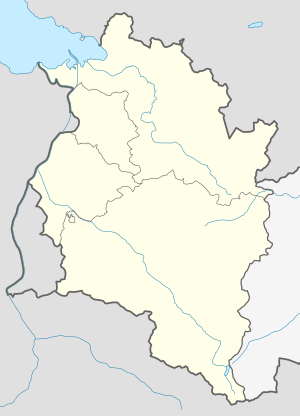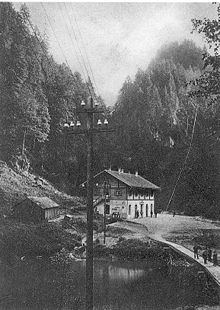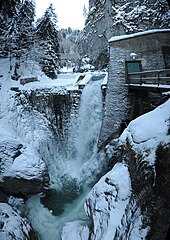Ebensand power station
| Ebensand power station | ||
|---|---|---|
| Ebensand power station | ||
| location | ||
|
|
||
| Coordinates | 47 ° 22 '41 " N , 9 ° 46' 36" E | |
| country |
Austria : Vorarlberg |
|
| place | Dornbirn | |
| Waters | Dornbirn Oh | |
| power plant | ||
| owner | illwerke vkw AG | |
| operator | illwerke vkw AG | |
| Start of planning | at the end of the 19th century | |
| construction time | 1898-1899 | |
| Start of operation | 1899 | |
| technology | ||
| Bottleneck performance | 1.8 megawatts | |
| Average height of fall |
174 m | |
| Expansion flow | 1.3 m³ / s | |
| Standard work capacity | 7 million kWh / year | |
| Turbines | 3 Pelton turbines | |
| Others | ||
| Website | www.illwerkevkw.at | |
The Ebensand power plant is a small run-of-river power plant operated by illwerke vkw in Dornbirn . After the Rieden power station built in 1891, Ebensand is the second oldest power station in Vorarlberg and was built in 1899 . It is currently the largest small power plant operated by illwerke vkw and supplies around 7 GWh of electrical energy per year . The turbines are driven by the Dornbirner Ach , which is then dammed in the Staufensee reservoir and drains through the Rappenloch Gorge.
history
prehistory
At the end of the 19th century the “Committee for the Introduction of Electric Lighting in Dornbirn” was set up. The industrialist Ignaz Rüsch became chairman of the lighting committee. As a result, several projects to build a power plant in the Dornbirn municipality were examined, including alternatives such as steam and coal-fired facilities. For cost reasons, however, it was finally decided in favor of a flow power plant against the steam alternative. Offers from the Austrian railway company and the Helios corporation, which were planning power plants on the Ill and the Bregenz Ach , were shortlisted . The only project in Dornbirn's municipality was that of the Siemens & Halske company .
Ignaz Rüsch, whose company, Rüschwerke, had been awarded the complete water-related part of the project by Siemens & Halske, stepped down as chairman of the lighting committee before the vote. Nevertheless, due to the pressure of the opposition in the municipal council, he ultimately had to give up his position as chairman to the liberal politician and industrialist Viktor Hämmerle before the vote could take place. Siemens & Halske agreed to the contract, as did the municipal council, which did so with a unanimous decision on December 22, 1897.
Power plant construction
The power station was finally built in the years 1898/1899 on behalf of the Dornbirn municipality with the associated Staufensee reservoir . The reservoir was built in 1897, but its dam wall had been reinforced and renewed accordingly by the construction of the power plant. Previously, this lake had only been used to regulate the water flow rates of the Dornbirner Ach in order to support the drifting of wood.
The company Ast & Co took over the construction of the supply tunnels and the storage basins, the power station building itself was built by the Dornbirn master builder Johann Alois Albrich. The already mentioned Rüschwerke supplied the pressure pipelines and the turbine components. At times, up to 300 workers were busy with the construction of the power plant, many of them experts in tunnel work from the Italian region of Trentino-South Tyrol . The total construction costs amounted to about one million crowns . Originally, a pressure pipe for the factories in Gütle was also led through the Rappenloch Gorge, which is connected to the reservoir and which still exists today.
The supply tunnel for the power plant was ceremoniously knocked through as early as October 1898, and the renewed and now 21 meter high dam of the Staufensee was completed in the same year.
Operation of the power plant
The power plant was officially commissioned by Siemens & Halske in 1898. The water was then drawn off in the Schanerloch and stored in a two-kilometer-long pressure tunnel with 13 tunnel windows . In this way, 4400 m³ of water could be stored in the tunnel with a cross-sectional area of 2.1 m². In accordance with the contract with the municipality of Dornbirn, Siemens & Halske also took over the installation of the line network in Dornbirn, whereupon the Dornbirn market square could be illuminated with electric light for the first time on May 6, 1898.
In 1905 the Kennelbach textile manufacturers Jenny & Schindler , from whose company VKW later emerged, took over the power station. The power plant had a decisive influence not only on the electrical street lighting in the city, but also on the construction of the Dornbirn – Lustenau electrical railway , an electrical tram built in 1901.
Although the power plant is still in operation today, it has largely lost its original meaning. Groups of visitors can visit Ebensand today. During the day, a niche in the building separated by glass can be entered through an entrance, from which one has a good view of the inside of the hall and of the two turbines.
technology
The water is drawn off at the “Schanerloch”, where it is diverted to the equalization basin via an almost two-kilometer-long operating tunnel and then fed to the power house via the 450-meter-long pressure tunnel. Electricity is generated by two sets of Pelton turbines :
- A single-jet Pelton turbine, manufactured in 1897 by the Dornbirn company Rüsch. It has a maximum output of 200 kW and is (except for the impeller) in its original condition.
- Two twin-nozzle Pelton turbines, manufactured in 1953 by the Andritz machine factory, with a maximum output of 1600 kW.
The turbines in this power house are driven with a water volume of 1.3 m³ / s. Until then, the height of fall is 174 m. The maximum power plant output is 1.8 MW with an annual generation of around 7 GWh, which corresponds to an average power plant output of around 800 kW.
Rock fall in the Rappenloch
On May 10, 2011 there was a massive rock fall in the Rappenloch Gorge at around 1 p.m. local time, which also tore the Rappenloch Bridge, which crossed the gorge at its narrowest and most spectacular point, with it. Due to the now reduced possibility of drainage due to the rock fall and the associated increase in the level of the water flow in this part of the Rappenloch Gorge, normal discharge of the alluvial material from the reservoir is no longer possible due to flooding, which means that the reservoir is threatened with silting up in a few years . This would have a direct impact on the functioning of the Ebensand power plant.



